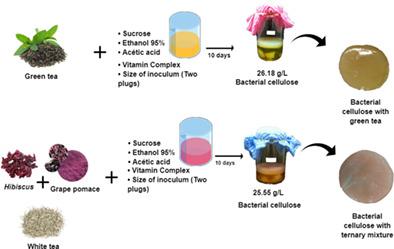当前位置:
X-MOL 学术
›
Polym. Eng. Sci.
›
论文详情
Our official English website, www.x-mol.net, welcomes your
feedback! (Note: you will need to create a separate account there.)
Hybrid bacterial cellulose‐collagen membranes production in culture media enriched with antioxidant compounds from plant extracts
Polymer Engineering and Science ( IF 3.2 ) Pub Date : 2020-09-02 , DOI: 10.1002/pen.25514 Isabela de Andrade Arruda Fernandes 1 , Giselle Maria Maciel 2 , Anna Lou Mucharski Strafit de Oliveira 2 , Avany Judith Ferraro Miorim 3 , Jose Domingos Fontana 4 , Valéria Rampazzo Ribeiro 1 , Charles Windson Isidoro Haminiuk 2
Polymer Engineering and Science ( IF 3.2 ) Pub Date : 2020-09-02 , DOI: 10.1002/pen.25514 Isabela de Andrade Arruda Fernandes 1 , Giselle Maria Maciel 2 , Anna Lou Mucharski Strafit de Oliveira 2 , Avany Judith Ferraro Miorim 3 , Jose Domingos Fontana 4 , Valéria Rampazzo Ribeiro 1 , Charles Windson Isidoro Haminiuk 2
Affiliation

|
Bioactive, structural, and mechanical properties were measured of a cellulose biopolymer produced by Gluconacetobacter xylinus using hydrolyzed collagen and phenolic compounds from teas and grape pomace (GP) in an optimized culture medium. Biopolymers were impregnated with an antibiotic to investigate possible antibacterial activities. Hybrid bacterial cellulose (BC)‐collagen membranes obtained from cultures with green tea and a ternary mixture (TM) of teas with GP presented a high concentration of phenolic compounds (879.7 and 1312.8 mg gallic acid equivalent per liter) and antioxidant activity (973.3 and 575.9 mmol/g), respectively. BC membranes included a nanodimensional network of microfibrils, and the addition of hydrolyzed collagen in the TM of teas in situ resulted in thicker structures with improved mechanical properties. BC‐collagen membranes pretreated with cephalexin exhibited significant inhibition against Escherichia coli and Staphylococcus aureus. The enrichment of the culture media with plant phenolic compounds and collagen resulted in the formation of hybrid BC membranes in a shorter time when compared to those produced without these components. Membranes modified with bioactive compounds in situ and antibiotics ex situ can be turned into potential products for application in biomaterials with antioxidant activity.
中文翻译:

在富含植物提取物抗氧化剂的培养基中生产细菌纤维素-胶原蛋白混合膜
测量了木糖葡糖杆菌生产的纤维素生物聚合物的生物活性,结构和机械性能在优化的培养基中使用茶和葡萄果渣(GP)中的水解胶原蛋白和酚类化合物。用抗生素浸渍生物聚合物以研究可能的抗菌活性。从绿茶和GP茶三元混合物(TM)的培养物中获得的混合细菌纤维素(BC)-胶原膜表现出高浓度的酚类化合物(每升分别为879.7和1312.8 mg没食子酸当量)和抗氧化活性(973.3和575.9mmol / g)。BC膜包括微纤维的纳米级网络,并且在茶的TM中原位添加水解胶原蛋白会导致结构更厚,机械性能得到改善。头孢氨苄预处理的BC-胶原蛋白膜对大肠杆菌具有明显的抑制作用和金黄色葡萄球菌。与不含这些成分的培养基相比,含有植物酚类化合物和胶原蛋白的培养基富集可在更短的时间内形成杂化BC膜。原位用生物活性化合物和异位抗生素修饰的膜可以变成潜在的产品,可用于具有抗氧化活性的生物材料。
更新日期:2020-09-02
中文翻译:

在富含植物提取物抗氧化剂的培养基中生产细菌纤维素-胶原蛋白混合膜
测量了木糖葡糖杆菌生产的纤维素生物聚合物的生物活性,结构和机械性能在优化的培养基中使用茶和葡萄果渣(GP)中的水解胶原蛋白和酚类化合物。用抗生素浸渍生物聚合物以研究可能的抗菌活性。从绿茶和GP茶三元混合物(TM)的培养物中获得的混合细菌纤维素(BC)-胶原膜表现出高浓度的酚类化合物(每升分别为879.7和1312.8 mg没食子酸当量)和抗氧化活性(973.3和575.9mmol / g)。BC膜包括微纤维的纳米级网络,并且在茶的TM中原位添加水解胶原蛋白会导致结构更厚,机械性能得到改善。头孢氨苄预处理的BC-胶原蛋白膜对大肠杆菌具有明显的抑制作用和金黄色葡萄球菌。与不含这些成分的培养基相比,含有植物酚类化合物和胶原蛋白的培养基富集可在更短的时间内形成杂化BC膜。原位用生物活性化合物和异位抗生素修饰的膜可以变成潜在的产品,可用于具有抗氧化活性的生物材料。









































 京公网安备 11010802027423号
京公网安备 11010802027423号